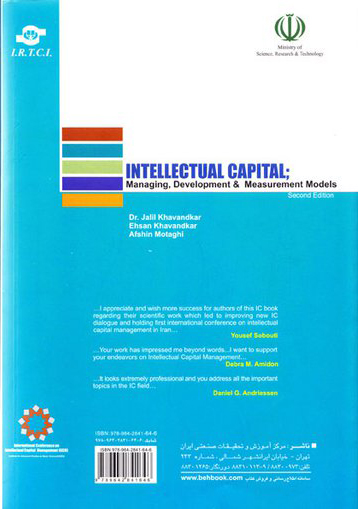Laureatesof 17th Iranian Student's Book of the Year announced. The book: “IntellectualCapital; Managing, Development and Measurement Model (authored by Dr.Jalil Khavandkar, Ehsan Khavandkar and Afshin Motaghi)’ won the 2010National Praiseworthy Prize for the Best Iranian Student`s Book of the Year inHuman Sciences/Business. This book is the first Persian book on Intellectual Capital was prefacedand admired by Iran Ministry of Science, Research and Technology, Debra Amidonwho is one of the first thinkers in IC issues, Prof. Yousef Sobouti who ismember of Third World Academy of Science (TWAS). It reached to its 2nded. in less than 4 months.
The closing ceremony of the 17th Student'sBook of the Year was held on November 21, 2010 in of Tarbiat ModarresUniversity, Tehran, Iran. The laureates of the 17th Student's Book of the Yearwere chosen in groups including Social and human sciences, translation, basicscience, arts and architecture, agriculture and natural sources, engineeringand medicine.
IranNational Library Cataloguing in Publication for this book:
Intellectual capital: managingdevelopment and measurement models / Jalil Khavandkar, Ehsan khavandkar, AfshinMottaghi.
p. cm.
Includes bibliographical references and index.
ISBN:978-964-2841-64-6
Published by: Iran Ministry of Science, Research and Technology in withcooperation of Industrial Research andTraining Center of IRAN with Collaborationof IRAN Ministry of Science, Researchand Technology
First published 2009
SecondPublished: 2009
Printed and bound in Iran.

More about book:
As it mentioned in the foreword of this book, which has wrote by Iran Ministryof Science, Research and Technology (MSRT)," This is the first book onmanagement and measurement of intellectual capital in Persian, Which is theresult of many years of scientific work and research by the authors. The resultof the assessment process before book publication showed that inclusive models,methods and guidelines presented in this book are comparable to similar publicationin the developed countries. Such updated publication in the field of modernbusiness, enterprise culture and managing intellectual capital canadvocate management and entrepreneurship in Iran. Therefore thestudying of this book is highly recommended to scientists, teachers andstudents of management, information technology, entrepreneurship and knowledgemanagement fields."
In the preface of this book, authors emphasis: ...The intensionfor publishing this book has been to clarify certain fundamental concept andalso the adoption of managerial approaches in regards to theintellectual capital. Our studies have been based on the past in-depth researchstudied of the author in classification, management requirements and models formeasuring the intellectual capital.....”.
Fulltable of content:
1 Introduction to IntellectualCapital
1.1 Knowledge What and How
1.2 Phenomenology of Business in Knowledge Economy
1.3 New Forms of Organizational Resource
1.4 Intangible Assets
1.5 Intellectual Capital
1.5.1 Human Capital
1.5.2 Structural Capital
1.5.1 Knowledge and Information Capital/Assets
1.6 Conclusion
2 Managing Development of Intellectual Capital
2.1 Intellectual Capital Management
2.2 Creation and Acquisition Patterns of Knowledge andInformation in Organization
2.3 Knowledge Management
2.3.1 Knowledge Management for Intellectual Capital
2.3.2 Knowledge Management in Human Capital
2.3.3 Knowledge Management in Organizational StructuralCapital
2.3.4 Knowledge Management in Relational Structural Capital
2.4 Culture Management
2.4.1 Culture Management in Human Capital
2.4.2 Culture Management in Structural Capital
2.5 Organizational Learning Management
2.5.1 Organizational Learning Management for IntellectualCapital
2.6 Organizational Capabilities Management
2.6.1 Organizational Capabilities Management for IntellectualCapital
2.7 Inter-organizational Partnerships Management
2.7.1 Inter-organizational Partnerships Management inRelational Structural Capital
2.8 Conclusion
3 Intellectual Capital Measurement
3.1 Performance and Performance Measurement
3.2 Assets Accounting
3.3 Intangible and Intellectual Capital Assets Accounting
3.4 Intellectual Capital Measurement
3.4.1 Descriptive Models for Intellectual Capital Measurement
3.4.1.1 Market Capitalization Models (MCM)
3.4.1.1.1 Tobin’s q
3.4.1.1.2 Invisible Balance Sheet
3.4.1.1.3 Market-to-Book Value
3.4.1.1.4 KNOWCORP
3.4.1.2 Direct Intellectual Capital Models (DIC)
3.4.1.2.1 Human Resource Costing & Accounting (HRCA)
3.4.1.2.2 HR statement
3.4.1.2.3 Citation- Weighted Patents
3.4.1.2.4 Technology Broker
3.4.1.2.5 Accounting for the Future (AFTF)
3.4.1.2.6 Inclusive Valuation Methodology (IVM)
3.4.1.2.7 Total Value Creation (TVC)
3.4.1.2.8 Intellectual Asset Valuation
3.4.1.2.9 The Value Explorer
3.4.1.2.10 FiMIAM
3.4.1.3 Return on Assets Models (ROA)
3.4.1.3.1 Economic Value Added (EVA)
3.4.1.3.2 Calculated Intangible Value (CIV)
3.4.1.3.3 Value Added Intellectual Coefficient (VAIC)
3.4.1.3.4 Knowledge Capital Earnings
3.4.1.4 Scorecard Models (SC)
3.4.1.4.1 Balanced Score Card
3.4.1.4.2 Holistic Accounts
3.4.1.4.3 Skandia Navigator
3.4.1.4.4 Intangible Asset Monitor
3.4.1.4.5 IC-Index
3.4.1.4.6 Value Creation Index (VCI)
3.4.1.4.7 Knowledge Audit Cycle
3.4.1.4.8 Value Chain Scoreboard
3.4.1.4.9 OECD Measurement Models for Knowledge Assets andIntellectual Capital
3.4.1.4.10 IC Rating
3.4.1.4.11 Dynamic Valuation of Intellectual Capital(IC-dVAL)
3.4.1.4.12 Measuring and AccountinG IntellectualCapital(MAGIC)
3.4.1.4.13 Business IQ
3.4.1.4.14 National Intellectual Capital Index
3.4.1.5 Visualization Models (VIS)
3.4.1.5.1 Knowledge Assets Map (KAM)
3.4.1.5.2 Performance Prism Model
3.4.1.5.3 Value
3.4.1.5.4 Strategy Map
3.4.1.5.5 Value Creation Map
3.4.1.5.6 Seer Model
3.4.2 Prescriptive Models for Intellectual CapitalMeasurement
3.4.2.1 International Federation of Accountants Guideline
3.4.2.2 Nordika Guideline
3.4.2.3 MERITUM Guideline
3.4.2.4 Italian Guideline
3.4.2.5 Spanish Guideline
3.4.2.6 Danish Guideline
3.4.2.7 German Guideline
3.4.2.8 Japanese Guideline
3.4.2.9 Australian Guideline
3.4.2.10 Austrian Guideline
3.4.3 Measurement Models for Knowledge Assets/Capital
3.4.3.1 World Bank’s Knowledge Assessment Methodology (KAM)and Scorecards
3.4.3.2 United Nations Economic Commission for Europe (ECE)
3.4.3.3 eEurope National Knowledge Assets Measurement
3.4.3.4 European KM Forum Assessment Model
3.4.3.5 e-Readiness Index
3.4.4 Intellectual Capital Tools
3.4.4.1 Celemi`s Tango Tool
3.4.4.2 Bates Gruppen`s Company IQ Measurement System
3.4.4.3 Ericsson’s Cockpit Communicator Tool
3.5 Conclusion
4 Intellectual Capital Bibliography
5 Intellectual Capital Glossary of Terms (English to Persian)
Appendix
References.